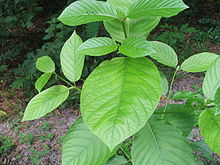Mitragynine
| Structural formula | |||||||||||||
|---|---|---|---|---|---|---|---|---|---|---|---|---|---|

|
|||||||||||||
| General | |||||||||||||
| Surname | Mitragynine | ||||||||||||
| other names |
(all- S , E ) -16.17-didehydro-9,17-dimethoxy-17,18-seco-20 α -yohimban-16 carbonsäuremethylester |
||||||||||||
| Molecular formula | C 23 H 30 N 2 O 4 | ||||||||||||
| External identifiers / databases | |||||||||||||
|
|||||||||||||
| Drug information | |||||||||||||
| Drug class | |||||||||||||
| properties | |||||||||||||
| Molar mass | 398.50 g mol −1 | ||||||||||||
| Physical state |
firmly |
||||||||||||
| Melting point |
102-106 ° C |
||||||||||||
| boiling point |
230-240 ° C |
||||||||||||
| solubility |
soluble in ethanol , chloroform and acetic acid |
||||||||||||
| safety instructions | |||||||||||||
|
|||||||||||||
| As far as possible and customary, SI units are used. Unless otherwise noted, the data given apply to standard conditions . | |||||||||||||
Mitragynine is a natural substance found in the kratom plant and belongs to the group of indole alkaloids .
Occurrence

The natural substance is obtained from the kratom plant ( Mitragyna speciosa ). The kratom plant contains about 0.25% mitragynine, the remaining alkaloids are indole alkaloids such as. B. Paynanthein , 7-hydroxymitragynine or ajmalicin .
Pharmacology and effects
Mitragynine is an analgesic , its effects are very similar to those of codeine , but without many of its side effects.
Use as an intoxicant
As early as the 19th century, kratom was used in traditional medicine in Malaysia as an opium substitute . The reason for this lies in the ability of mitragynine to bind to μ - and k - receptors , whereby an opium-like psychotropic effect occurs , at least at high doses . Mitragynine also has a stimulating effect on the motor centers of the central nervous system, especially in lower doses. However, there is a high health risk if it is consumed together with MAOIs . Several deaths have been described in combination with more potent µ-opioid receptor agonists. Long-term use can lead to dependence that is very similar to opioid addiction. Another side effect reported is hyperpigmentation of the cheeks.
further reading
- EJ Shellard: The alkaloids of Mitragyna with special reference to those of Mitragyna speciosa, Korth. UNODC, Bulletin on Narcotics, 1974. pp. 41-55. Online version
Individual evidence
- ↑ a b c Lycaeum Entheogen Database: Mitragynine ( Memento from April 24, 2016 in the Internet Archive ), accessed July 10, 2020
- ↑ This substance has either not yet been classified with regard to its hazardousness or a reliable and citable source has not yet been found.
- ↑ Francisco León et al.: Phytochemical characterization of the leaves of Mitragyna speciosa grown in USA In: Natural Product Communications 4, no. 7 (July 2009): 907-910.
- ↑ JB Harbourne: Phytochemical Dictionary. Taylor & Francis. 1998. p. 208. ISBN 0-7484-0620-4 .
- ↑ Kazuo Watanabe et al .: Pharmacological properties of some structurally related indole alkaloids contained in the Asian herbal medicines, hirsutine and mitragynine, with special reference to their Ca 2+ antagonistic and opioid-like effects. In: Raymond Bonnett, Wantanabee, H Watanabe: Pharmacological Research on Traditional Herbal Medicines. Taylor & Francis 1999. ISBN 90-5702-054-8 , p. 163 ff.
- ↑ Th. Velocity: Intoxicating drugs. Market forms and modes of action. Heidelberg, Dordrecht, London, New York: Springer, 2013. pp. 203 f. ISBN 978-3-642-30162-9 .
- ↑ R. Kronstrand, M. Roman, G. Thelander, A. Eriksson: Unintentional fatal intoxications with Mitragynine and O-desmethyltramadol from the herbal blend Krypton. In: Journal of analytical toxicology. Volume 35, Number 4, May 2011, pp. 242-247, PMID 21513619 .